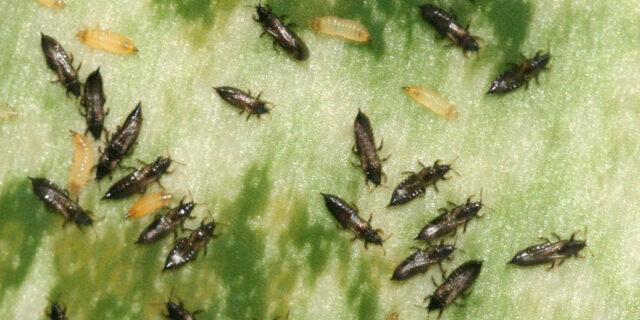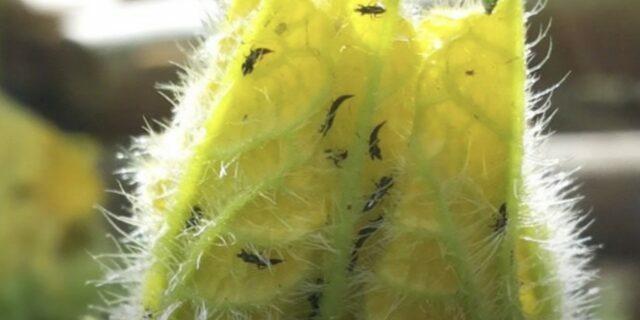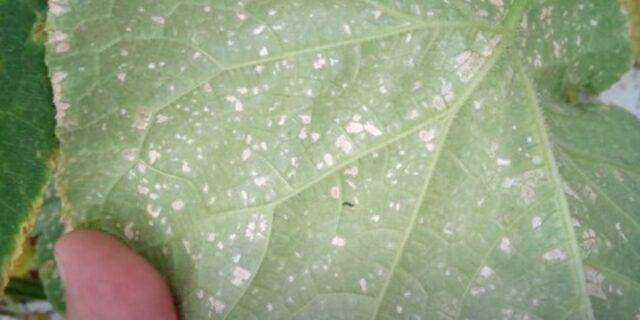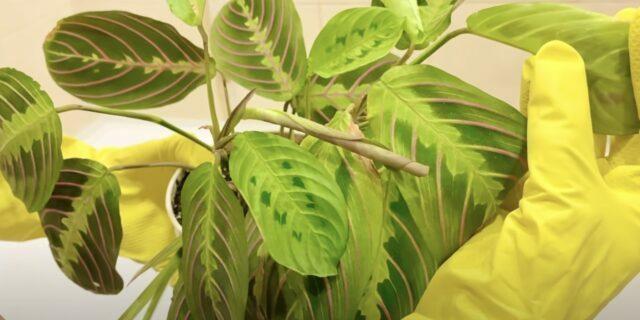Thrips on strawberries, roses, cucumbers and houseplants: photo and fight
Miscellaneous / / July 13, 2023
These methods will save plants both at home and on the site.
What do thrips look like and why are they harmful?
Thrips are small insects up to 1.8 mm in size. They are black, brown, white, burgundy. Pests reproduce very actively: one female, on average, lays 50 eggs at a time. At a temperature of about 30 degrees, after 4–5 days, larvae are obtained from them; in cooler weather, this takes about 13 days.

1 / 0
Larvae and adults of thrips. Photo: Wikimedia Commons

2 / 0
Small thrips are difficult to see with the naked eye. Frame: House Plant Journal / YouTube

3 / 0
Thrips are dark in color. Frame: Young Gardener / YouTube
Adult thrips and larvae feed on plant sap, literally sucking the life force out of them. At best, cultures lose their decorative effect and slow down development; at worst, they die. Most often, insects settle on indoor plants, but can also settle in garden and vegetable garden. For example, pests can be found on roses, carnations, chrysanthemums, cucumbers, tomatoes, peppers, strawberries and grapes.
Thrips are quite difficult to spot because of their diminutiveness. But the appearance of plants will tell about the presence of pests: small holes-punctures and silvery spots on the leaves, their twisting, drying out and falling off.

1 / 0
Traces of thrips activity on leaves. Frame: Young Gardener / YouTube

2 / 0
Leaves twisted due to thrips. Frame: MARINA ZHUKOVA / YouTube
It is better to start the fight against thrips as soon as you notice signs of their appearance. If you start the situation, insects will begin to multiply at a crazy speed and it will be extremely difficult to get rid of them.
How to get rid of thrips with green soap
Green soap is a thick substance found in grocery stores and garden centers. The tool is considered safe and can be used to process vegetables and fruits at the ripening stage of the crop.
To prepare a working solution, dilute 40 ml of soap in 1 liter of warm water. Spray the plants thoroughly, trying to hit both the outer and inner parts of the leaves. If you work in the garden, and not in the house, then carry out the procedure in dry weather, early in the morning or late in the evening, so that drops of the solution do not burn the bushes under the influence of sunlight.
Processing repeat every 5-10 days until the thrips are completely gone.
By the way, green soap is also available as a ready-made solution in spray bottles. In this case, the product does not need to be pre-diluted with water.
How to get rid of thrips with tobacco dust
This tool is considered safe, so it can be used even when the fruits have already begun to sing.
Generously sprinkle tobacco dust on plants and soil in the beds and flowerbeds or in pots. For best results, turn the leaves over and dust them on the inside.
Work on the site in dry weather, and after precipitation, wait until the plants dry and renew the layer.
How to get rid of thrips with special drugs
Insecticides are perhaps the most effective means of pest control. There are two types of drugs - chemical and biological. Both can be safely used for indoor plants as well as outdoor ornamental crops before flowering. Chemicals can kill not only pests, but also beneficial insects like bees. Therefore, if there are blooming flowers on the bush, use biological products. They should also be used on vegetable and fruit crops from the beginning of flowering to harvest. So products from the garden and vegetable garden will not contain harmful substances.
The most popular chemical preparations are Aktara, Actellik, Alatar, Inta-vir and Iskra, among biological ones - Fitoverm, Antitlin, Bitoxibacillin. The consumption rate and method of preparing the solution are indicated in the instructions and may vary depending on the manufacturer. To combat thrips, you will need to spend 2-3 processing with an interval of 10 days.
Spray the leaves of the plants thoroughly on the inside and outside, as well as the soil around them. Do this in dry weather early in the morning or in the evening so that the solution, combined with the sun's rays, does not burn the foliage.
Read also🐛
- How to deal with powdery mildew on cucumbers and other plants
- How to get rid of a wireworm
- How to get rid of aphids with store or folk remedies
- How to get rid of cabbage and save the crop
- What to do if scab appears on trees, bushes and vegetables


